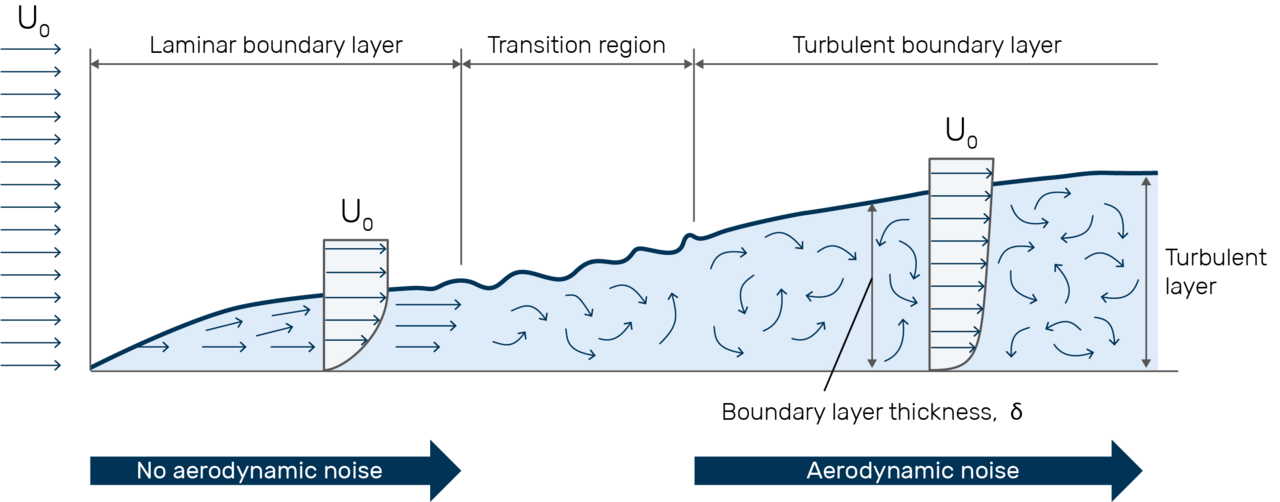Understanding laminar flow, turbulent flow and the transition region
As examined in the What is the difference between acoustic and aeroacoustics? article, the studies of aerodynamics and aeroacoustics are bound together. Using microphones, surface- or flush-mounted, in a wind tunnel focuses on measuring the characteristics of air pressure in the boundary layer of an object in flow through a medium (or the medium around the object).
In the early 1900s, Ludwig Prandtl published a paper wherein he defined what is now called the boundary layer. Ever since, the definition of this layer has been a huge benefit to the study of aerodynamics and of great practical use for acquiring data for aerodynamic/aeroacoustic analysis. The flow around the device under test (DUT) in the wind tunnel is divided into two parts. The closer area, the area of interest in data acquisition, is that same boundary layer defined by Prandtl. This layer is so important because it is characterized by being a viscous layer in between the DUT and the free-flowing medium unaffected by the DUT.
Flow in the boundary layer can be further divided into two main types: 1) laminar and 2) turbulent—with a transition region in between.

Boundary layers in flow.
Laminar flow
Laminar flow is characterized by fluid particles following smooth paths in parallel layers with little or no disruption between the layers. Laminar flows have a parabolic velocity profile. The velocity of the flow is at its lowest at the walls and highest in the center of the stream.

Laminar flow in a closed pipe. The length of the arrows shows the approximate velocity of the fluid flow.
Turbulent flow
Turbulent flow is fluid motion characterized by chaotic changes in pressure and flow velocity.

Turbulent flow in a closed pipe.
Transition region
Measurement in boundary layers using microphones to register the changes in air pressure places a considerable focus on separating the acoustic signal from flow-induced turbulent or hydrodynamic noise. Special attention is paid to determine the exact location where the flow goes from laminate (relatively quiet) to turbulent and noisy. This location is called the transition region.
Microphones or pressure sensors can be used to monitor the transition region because turbulence has a characteristic acoustic signature that can be differentiated from laminar-flow acoustic signatures. The level of the turbulence increases from the transition region to the turbulent region, and results in vortical systems forming behind obstacles. These vortices and turbulence travel with a velocity comparable to the flow velocity and are the main sources of hydrodynamic/aerodynamic noise. When the speed is high enough, the acoustic component of the DUT is typically very small in amplitude compared to the hydrodynamic noise.
Understanding flow
The transition region is very important—for example, when dealing with stall in an airfoil (such as the wings of a plane). In aeronautics, stall is the condition where maximum lift is achieved and where, if the angle of attack increases or decreases, lift begins to decrease. When the angle of attack increases, the separated flow region moves forward and affects lift and increases drag. This means that the optimal angle (maximum lift and minimal drag) correlates to the location of the separation or transition region. This optimal angle also ensures minimum fuel consumption and noise production.
But, it is not only for aircraft optimization where an understanding of the transition region is needed—maximizing efficiency for wind-turbine blades and reducing the effects of drag and turbulence on motor vehicles are also of paramount importance. In modern vehicles, by about 70 km/h, both tire-road noise and engine noise are masked by wind-induced noise, and more than 50% of a vehicle’s energy is required just to fight aerodynamic resistance. This means that the key to making quieter and more energy-efficient vehicles is understanding where turbulences occur and being able to locate and quantify the transition region.
Companies are spending massive sums of money on wind-tunnel measurements, simulation software and expert consultancy to gain even minor improvements in the aerodynamic performance. The trend towards e-mobility and the associated technologies only makes the focus on quiet efficiency more important, not less. Understanding the aerodynamic properties of an object in flow and the resulting aeroacoustic elements is the key to increasing performance and comfort for any plane, turbine blade or vehicle moving through the air. Gaining a better understanding of the component parts of the flow and developing the tools and techniques to acquire actionable data will be a great benefit in all aspects of the development process, from initial data acquisition and finite element model generation through prototyping and model validation to the final product—quieter, more efficient and with a lower overhead cost.









